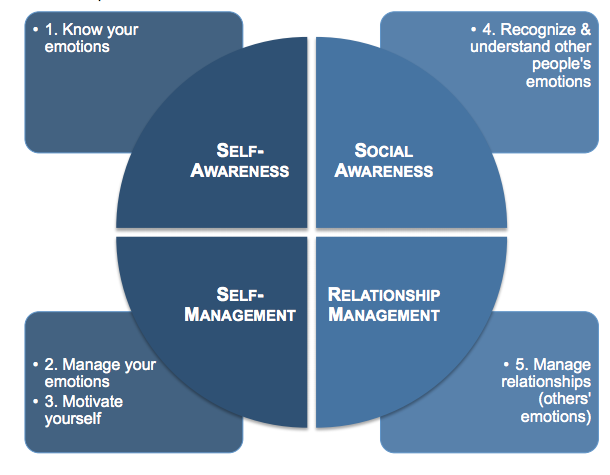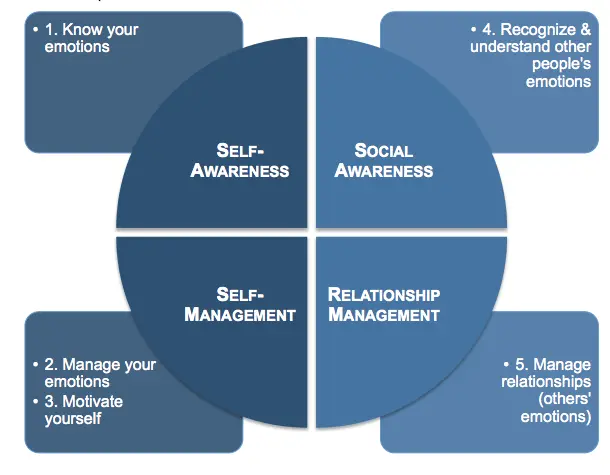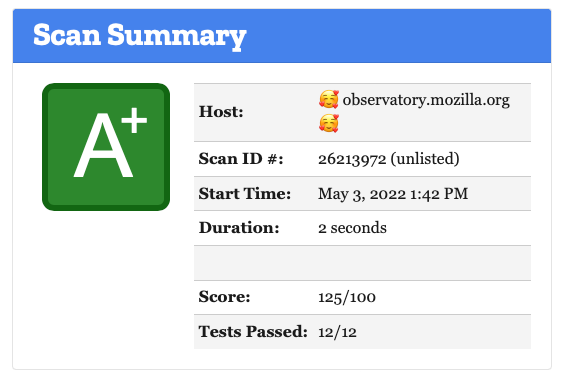Over the 4th of July weekend, I finished reading the book, Emotional Intelligence 2.0. Thank you Craig Utley for the recommendation! EQ 2.0 is a wildly popular and seminal work that has had a tremendous impact on how people think about emotional intelligence. The authors define emotional intelligence as four core skills.
I will now summarize the four skills along with the book's 66 strategies for increasing EQ.
"Emotional Intelligence 2.0 has one purpose, increasing your EQ." (9)
EQ comprises four skills...Self Awareness, Self Management, Social Awareness, and Relationship Management.

A high EQ pays off. For every single point increase in EQ, you can expect an increase of $1,300 to your annual salary! (21)
The 4 skills
Self Awareness
83 percent of people high in self-awareness are top performers, while just 2 percent of bottom performers are high in self-awareness (26). Self-awareness is an ability to accurately perceive your own emotions and understand your tendencies across situations (24).
Self Management
Self-management is your ability to use awareness of your emotions to choose what you say and do (32). Successful 'self-managers' put their immediate needs on hold in pursuit of larger, more important goals (33).
Social Awareness
Social Awareness is an ability to pick up on emotions in other people and understand what is really going on with them. The key to social awareness is focusing on others, instead of yourself (144). This means being able to perceive what other people are thinking and feeling even if you do not feel the same way (38).
Relationship Management
Relationship Management is about making choices and acting to create an honest, deep connection with others (197). It's also an ability to use awareness of your own emotions and those of others to manage interactions successfully (44).
What is my EQ?
The first step to increasing EQ is finding out where you currently stand with each of the four skills. I took the official test, but there are plenty of free assessments that will gauge your competence, like this one. The authors recommend taking an assessment, working on your deficient skills, and then re-testing after 6 months (55).
Unlike IQ, we can increase EQ. It's not about your brain's processing power. It's four skills you practice. The first two skills, Self and Social Awareness, involve an ability to discern emotions in yourself and others.
Self-Awareness Strategies (1-15)
The first step to self-awareness is realizing emotions are not black and white. Once we avoid classifying emotions as either 'good' or 'bad', we can recognize the subtleties and move toward understanding (strategy 1). This might be uncomfortable at first, but as you lean into discomfort (strategy 3), you will notice how actions and emotions in one person send out ripple effects (strategy 2). One angry person can affect the entire room.
Our brain and body enter into feedback loops; Feelings are felt in the body and mind alike (strategy 4). I feel anxiety as a stomachache. The good news is that you can affect the other by changing one! Simply putting on a smile will make you happier!
If you watch yourself (strategy 6), you will notice who and what pushes your buttons (strategy 5). For strategy 5, list out things that 'trigger you.' Even better if you can maintain a journal (strategy 7). I came up with:
Loud environments, repeating myself, feeling controlled, people not doing things the 'right' way, being interrupted.
Strategies 8 and 9 warn you not to be fooled by 'bad' and 'good' moods. I sometimes tell my wife things like, "I am just in a bad mood today." But that's a copout. There's always a source of each emotion!
Once you have identified a few of your triggers and negative reactions, it's time to ask yourself why you do the things you do (strategy 10) as well as revisiting your values (strategy 11) to check if your actions are in alignment with your principles (strategy 12). I have the following core values:
Patience, Kindness, Thankfulness, Humility, Respect, Servant-Leadership, Equanimity, Forgiveness, Truth, Courage, Integrity, Optimism, and perseverance².
If your actions don't match your principles, it's time to re-evaluate them!
Finally, look to books, music, movies, and TV shows to see what lyrics and characters you most connect with (strategy 13). You can also ask others you trust for consecutive feedback (strategy 14), especially when you are under stress (strategy 15).
Self-Management Strategies (1-17)
When emotions are high, breathe right (strategy 1). Take deep breaths that expand your belly. Shallow breathing is associated with poor concentration, forgetfulness, mood swings, restlessness, depression, anxious thoughts, and lack of energy (102). Once you have your breath under control, create an emotion vs reason list when you are in a tense moment (strategy 2).
A great way to boost motivation is to make your goals public (strategy 3). Select a group of trusted friends or family and ask them to keep track of your progress!
Other strategies for managing yourself include counting to 10 before responding to a trying situation, taking mental rest breaks, getting enough sleep, and finding a mentor who has a higher EQ than you and is not emotionally invested in the situation (strategies 4, 5, 6, 14, 16).
Throughout your day, smile and laugh more (strategy 7), Set aside time to think through problems (strategy 8) and take control of self-talk (strategy 9). Signs you might have negative self-talk include phrases such as "I always/never do <X>." When you feel the urge to blurt, "Gosh, I'm an idiot", replace those words with factual statements like, "I made a mistake" (119).
MRI scans show there is little difference between imagining events and actually experiencing them (120). For that reason, it's helpful to visualize yourself succeeding in social interactions (strategy 10). Strategy 11 focuses on sleep hygiene. Although the book included some good tips, I much prefer this sleep hygiene article published by the Sleep Foundation.
Similar to strategy 9 (self-talk), it's essential to use positive language with yourself and others. Positive language focuses on what is possible instead of what isn't (strategy 12).
Besides working on your language and self-talk, ensure your body language matches what you are trying to communicate (strategy 13). If you want to get good with body language, I recommend reading What Every Body is Saying. It's written by an Ex-FBI agent who is an expert in speed-reading people.
Finally, it's important to realize that change is just around the corner (strategy 17) and you can increase your EQ with each person you encounter (strategy 15).
Social Awareness Strategies (1-17)
Dale Carnegie famously said in How to Win Friends and Influence People³
"Remember that a person’s name is to that person the sweetest and most important sound in any language." - Principle 3
Greeting people by name is a strategy to live by (strategy 1) (139).
Much like strategy 13 for Self-Management, so too should you be paying attention to the body language of others (strategy 2). Once you get down names and body language, it's time to work on your timing. I've learned over the years that it's not just about saying the right things; it's also about having the right timing (strategy 3). When there are long pauses in conversation, it's helpful to have a back-pocket question (strategy 4). These are phrases to restart the conversation, such as, "What do you think about [fill in the blank]"(145).
One of the most important keys to raising your awareness is to be in the moment (strategy 8). It's easy if you remember that the purpose of a conversation is to listen and learn something, not to wow the other person with insightful remarks (153). Before employees headed off to the Esri User Conference, CEO Jack Dangermond would tell us, "Be interested, not interesting."⁴ Some ways to stay present include silencing the voice inside your head (strategy 7), not taking notes/working during meetings (strategy 5), and taking some time to walk around and catch the mood of the room (strategies 9, 17). In can also help a lot if you plan for gatherings and meetings so you can be 100% present (strategy 6).
When taking part in conversations, practice the Art of Listening (strategy 11).
"Listening isn't just about hearing words; it's also about listening to the tone, speed, and volume of the voice. What is being said? Anything not being said? What hidden messages exist below the surface? You may have sat through a speech or presentation where powerful words were chosen, but the tone, speed, or volume didn't match the power of the words. Instead, these likely matched the speaker's frame of mind."
We have all heard the term, 'When in Rome, do as Romans do.' You'll never master social awareness until you understand the rules of the culture game (strategy 13). If you've traveled around, you'll have noticed people act differently from place to place. That reminds me, have you heard of the high context vs low context continuum for cultures around the world?

I used to work with someone who was Swiss. He was the type of guy that was bald on record. He sugarcoated nothing!
As you go about the world, attempt to understand the complete picture (strategy 16). Take a moment to step into the shoes of your fans and critics (strategy 15). Ask yourself, "If I were Jim, how would I respond to this question?" (170). Before declaring social awareness success, test for accuracy (strategy 14). The best way to test your accuracy is simply to ask if what you're observing in people or situations is actually what's occurring (166).
Relationship Management Strategies (1-17)
You won't see it on a job description, but maintaining relationships is one of the most important aspects of any job. When I left my last position, the #1 ask from my manager and coworkers was a list of the people with whom I had built relationships.
As with any relationship, it's important to build trust (strategy 6). This includes being open and curious (strategy 1), and not sending mixed signals (strategy 3). When people know about you and you communicate well, there's less room for them to misinterpret you (180). For example, expressing anger too much or at the wrong times desensitizes people to your feelings, making it hard for others to take you seriously (strategy 8).
Everyone has a natural communication style (strategy 2). The book suggests writing down your natural style on paper (183). Is it direct, indirect, comfortable, serious, entertaining, discreet, controlled, chatty, intense, curious, cool, or intrusive? On the left side of the paper, jot down the upsides of your natural style. On the right side, list downsides or things that have created confusion, weird reactions, or trouble. Once your list is complete, choose three upsides and three downsides. Think about ways to flex the upsides and eliminate, downplay, or improve the downsides.
As you go through this process, it's crucial you're able to take feedback well (strategy 5), and if someone has helped you along your EQ journey, remember to say 'Thank you! (strategy 12). It's the little things that pack a punch (strategy 4).
One of the best ways to increase your EQ is to simply be around people more. Letting others know you have an open door policy (strategy 7) will make you more accessible and literally 'open' more opportunities for you to practice your skills. Remember that you don't want to stretch yourself too thin (193). Make sure to have boundaries!
In all your relationships, do make sure to acknowledge the other person's feelings (strategy 10) and don't avoid the inevitable (strategy 9). When I was dating my wife Holiday, we got all our crap out in the open before we made a long-term commitment. We also made sure to listen and validate each other's thoughts and feelings. It feels good to build relationships without reservations.
When interacting with people, complement the other person's emotions or situation (strategy 11). This doesn't mean mirroring them. It means meeting their emotion with one that is a perfect fit. After all, a soft answer turns away wrath, but a harsh word stirs up anger⁵.
When making decisions, explain them, don't just make them (strategy 13).
"To support an idea, we need to understand why the decision was made...Transparency and openness make people feel like they are trusted, respected, and connected to their organization−instead of being told that to do and kept in the dark" (209).
This reminds me of the idea of a data culture where organizations make decisions based on data rather than individual opinions. When everyone has access to the metrics that drive decisions, everyone can get on board and cultivate change together.
One of the most important reminders I got from this book was to match my intention with my impact (strategy 15). This is a very powerful concept that I think most people get wrong. I'm serious, most people (including me) completely miss the mark here.
"Matching your intention with you impact means the ACTions you take have the reACTions you wanted." - John Solly
There's some telltale signs your intention did not match your impact. Phrases like, "I'm just joking", "I was just trying to help", "But I didn't mean it that way!", "I wasn't trying to be X", "I thought you would be thankful...", "You shouldn't be so upset..." are common signs you missed the mark.
While these statements might be true, we can't control how people react, but we CAN control how we act. Being able to successfully create the impacts we want with the actions we take is a great skill!
The final strategies revolve around conflict management and how to give feedback. When giving feedback, make it direct and constructive (strategy 14). After all, providing feedback is a relationship-building event that requires all four EQ skills to be effective. The question we should be asking ourselves is, "How does this person need to hear your message so it's clear, direct, constructive, and respectful?" (211-212).
When conversations go off the rails, try offering a "fix it" statement (strategy 16). It can be as simple as "This is hard" or asking how the other person is feeling (218). The last strategy is all about tackling tough conversations (strategy 17). Some tips include starting a conversation with an agreement, asking the other person to help you understand his or her side, resisting the urge to plan a "comeback", and staying in touch after the conversation concludes. One of my favorite books on this topic is Crucial Conversations. If you want a crash course, here's a good article on employing Crucial Conversation's STATE method to resolve conflict.
If you liked this summary, let me know in the comments! I am also open to summarizing other books if I get some good suggestions. Let's all increase our EQs together 📈
References
¹Bradberry, Travis, and Jean Greaves. Emotional Intelligence 2.0. TalentSmart, 2009.
²1 Corinthians 13:4-8 (ESV)
³Dale Carnegie's Lifetime Plan for Success: How to Win Friends & Influence People ; How to Stop Worrying & Start Living: the Great Bestselling Works Complete in One Volume, by Dale Carnegie, Galahad Books, 1998, p. 79.
⁴Direct quote. CEO Jack Dangermond, Esri
⁵ Proverbs 15:1 (ESV)

John Solly
Hi, I'm John, a Software Engineer with a decade of experience building, deploying, and maintaining cloud-native geospatial solutions. I currently serve as a senior software engineer at New Light Technologies (NLT), where I work on a variety of infrastructure and application development projects.
Throughout my career, I've built applications on platforms like Esri and Mapbox while also leveraging open-source GIS technologies such as OpenLayers, GeoServer, and GDAL. This blog is where I share useful articles with the GeoDev community. Check out my portfolio to see my latest work!



Comments